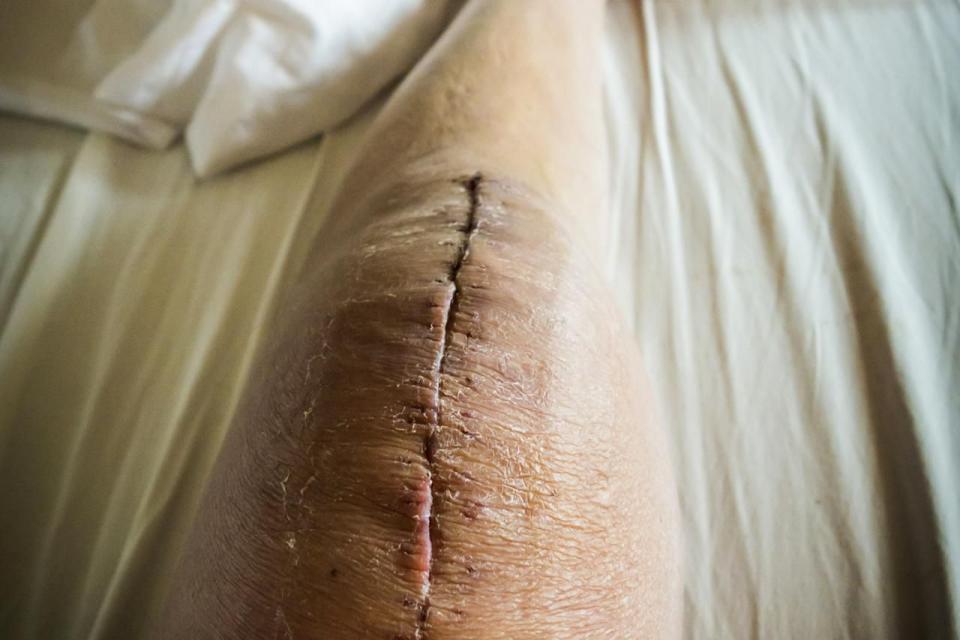Serosanguineous Drainage From a Wound
Learn what's normal and abnormal, and what to look for

Jan Hakan Dahlstrom / Getty Images
Medically reviewed by Jennifer Schwartz, MDFact checked by Nick Blackmer
Serosanguineous discharge is a normal drainage of fluid from a wound or incision site after surgery. The serum is a thin, often slightly yellow fluid that's mostly water, with a light pink tinge (the sanguine, or blood, element in the fluid). It typically lasts a few days as a wound heals.
However, there are times when the drainage—known as exudate—may seem abnormal either in its duration, consistency, color, or smell. These could be signs of slow healing, an infection, or an injury to a vein or artery. Knowing the difference can help you know when it's time to seek medical care.
This article explains serosanguineous discharge and its causes. It also presents other types of wound drainage, comparing what is normal and what is not, to help you better understand your symptoms.

What Is Serosanguineous Discharge?
Serosanguineous discharge is normal as a wound or surgical incision heals. There may be some short-term bleeding, but that tends to resolve quickly and be followed by a thin fluid discharge.
The discharge may be clear or slightly pinkish in color depending on how many tiny blood vessels, called capillaries, are damaged. The discharge may even have a few visible clots or blood streaks, but the fluid should become clearer as the healing process begins.
The color and consistency of the drainage can vary based on which component of blood is leaking from the wound. These elements include
Plasma: Blood serum in plasma is light yellow in color. It transports blood cells throughout the body.
Red blood cells: Also known as erythrocytes, these cells give blood its red color.
White blood cells: Also known as leukocytes, these cells help fight infection and disease.
Platelets: Also known as thrombocytes, these cells help blood clot to stop bleeding.
Although serosanguineous drainage is a normal part of a healing process, it also is the most common symptom of surgical wound infections.
With normal wound drainage, serum from blood plasma will be the main fluid seeping from the wound. Even so, there may be variations in the amounts and color of the fluid drainage.
Causes of Serosanguineous Drainage
Serosanguineous drainage is common during the healing process of a wound. Although it lasts a few days, the drainage can continue longer, depending on the size of the wound and how fast you heal. Many people will experience this fluid discharge in the six weeks following surgery.
The drainage often occurs when you need to change a bandage or wound dressing, and the capillaries found in the healing tissues are disrupted in the process.
Certain health conditions or medications that affect your ability to heal also may contribute to serosanguineous drainage and how long you have it. For example, a low platelet count or the use of blood thinners like Coumadin (warfarin) can affect your blood clotting ability and slow the healing process.
When to Call a Healthcare Provider
While serous or serosanguineous drainage is normal in small amounts, call your surgeon or healthcare provider if the drainage is profuse or persists for longer than 72 hours.
Related: Healing Your Scabs After Surgery
Other Types of Drainage
Other types of drainage can occur as your wound heals. The discharge and mild inflammation at the site are often part of the normal healing process. With proper wound care, drainage from an incision should resolve without incident.
There are times, however, when an infection or injury can cause abnormal wound healing. These other types of wound drainage may require that you contact your surgeon or healthcare provider without delay. In some cases, you may need to seek emergency care.
Serous Drainage
Plasma is composed primarily of serum, a fluid consisting mostly of water, and proteins called fibrinogens that work with platelets to help your blood clot. Serum is also known as serous fluid or serous exudate.
Serous drainage means that the fluid seeping from a wound is thin and watery with a slightly yellowish hue. There may be crusting around the wound due to the clumping of fibrinogens.
Serous drainage typically occurs in the first few days after surgery. It may be accompanied by redness, swelling, and warmth around the incision, which is a normal inflammatory response that helps aid with healing.
Sanguineous Drainage
Sanguineous drainage is when thicker red blood is draining from the wound. It can occur when there is a deep incision through multiple layers of tissues. It can also occur if a larger blood vessel is accidentally cut or nicked or you overexert yourself before a wound has healed enough.
Sanguineous drainage usually happens soon after surgery and may resolve on its own once there is ample clotting. Even so, it is never considered normal and should be seen by a healthcare provider immediately.
Hemorrhagic Drainage
Hemorrhagic drainage is when blood is freely flowing from a wound. It usually occurs when an artery or vein has been damaged.
If the blood is bright red and spurts or gushes, it means that an artery has been ruptured. If the blood is dark red and steadily flowing, it means that a vein has been ruptured.
Emergency care is an absolute necessity. Surgery, blood transfusions, and intravenous (IV) fluids may be needed to stop the bleeding and avoid severe complications, including shock and death.
Hemorrhagic drainage can be life-threatening depending on the amount of blood lost, how difficult the bleeding is to control, and how long the bleeding has gone unchecked.
Learn More: Hemorrhage Types and Treatment
Purulent Drainage
Purulent drainage involves the presence of pus. Pus is a thick fluid made up of dead cells, tissues, and bacteria that can develop when there is an infection. Pus often has a foul smell and can be many different colors, including white, yellow, gray, green, or brown.
With purulent drainage, there may be other signs of infection including fever, chills, and increasing redness, pain, and swelling on or around the incision site. There may even be wound dehiscence (in which the incision starts to open up).
Purulent drainage needs to be seen by a healthcare provider as a matter of urgency to avoid complications like cellulitis and sepsis infections. The treatment may involve oral, topical, and/or IV antibiotics, depending on the severity.
Related: What to Do About Pus From a Wound
Seropurulent Drainage
Seropurulent drainage means that serum and pus have mixed together to form a milky, white discharge. The discharge may have a foul smell or no smell. There may also be signs of an infection, such as fatigue, low-grade fever, and swelling, redness, and tenderness at the incision site.
Even if the infection is milder, you need to see a healthcare provider to ensure that you are given the right treatment and that the infection doesn’t get worse.
When to Seek Medical Care
Drainage from a surgical wound can tell you a lot about whether the site is healing properly or not. So can the length of time you experience symptoms. Serosanguineous drainage should last for a few days because it's part of the normal wound healing process.
Beyond that, drainage may be cause for concern. For example, the discharge may indicate infection as you recover from a surgical procedure. You'll want to follow your surgeon's instructions carefully during your recovery and contact them if drainage lasts more than a few days.
Here are some additional differences between normal and abnormal wound drainage that can help you to decide when it is time to see a healthcare provider.
Normal
The drainage is clear, slightly yellow, or tinged with pink.
The fluid discharge is thin and watery.
The drainage has no odor.
There is only a very small amount of bleeding.
Pain, swelling, and redness are improving.
Abnormal
The drainage contains large amounts of blood.
The drainage is milky or yellow, grey, green, or brown.
The drainage smells foul.
There is a steady flow or gushing of blood.
Pain, swelling, and redness are getting worse.
Related: How to Care for Surgical Incisions
Summary
Normal wound drainage involves the serosanguineous discharge of thin, watery fluids that may be clear or contain tiny amounts of blood. Abnormal wound drainage is when the discharge is thick, bloody, or has a milky white, yellow, green, gray, or brown color (often with a foul smell).
Abnormal wound drainage should be seen by your surgeon or healthcare provider without delay. If there is significant bleeding that doesn’t stop, rush to your nearest emergency room.
Frequently Asked Questions
Should I drain the pus out of an infected wound?
No, you should not drain the pus yourself. It is important to get the underlying infection treated by a healthcare provider, usually with antibiotic drugs. The pus may need to be drained, but doing so yourself can push the pus into deeper tissues and make the infection worse.
What are the types of surgical drains?
Two common surgical drains are chest tubes and bulb-type drains. A chest tube drains fluids that gather around the heart or between the lungs and chest wall. Bulb-type drains, such as the Jackson-Pratt (JP) drain, use a rubber bulb to draw fluid out of the body with gentle suction.

